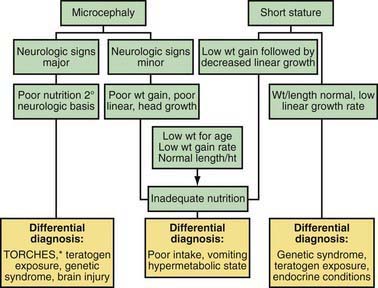Chapter 38 Failure to Thrive
Failure to thrive (FTT) is the result of inadequate usable calories necessary for a child’s metabolic and growth demands, and it manifests as physical growth that is significantly less than that of peers. No one set of growth parameters provides the criteria for a universal definition of FTT, although the pattern may be helpful (Fig. 38-1). FTT has classically been grouped into organic and nonorganic causes, but FTT is better defined as the end result of inadequate usable calories with contributing risk factors from multiple categories.

Figure 38-1 Approach to the differential diagnosis of failure to thrive. *See key to Table 38-1.
(Derived from Gahagan S: Failure to thrive: a consequence of undernutrition, Pediatr Rev 27:e1–e11, 2006.)
Epidemiology
The prevalence of FTT depends on the risks within populations. In developing countries or countries torn by conflict, infectious diseases, and inadequate nutrition are the primary risks. In developed countries, the primary risks are preterm birth and family dysfunction. In all settings there are a myriad of other causes (Table 38-1).
Table 38-1 FAILURE TO THRIVE: DIFFERENTIAL DIAGNOSIS BY SYSTEM
PSYCHOSOCIAL/BEHAVIORAL
NEUROLOGIC
RENAL
ENDOCRINE
GENETIC/METABOLIC/CONGENITAL
GASTROINTESTINAL
CARDIAC
PULMONARY/RESPIRATORY
MISCELLANEOUS
INFECTIONS
Stay updated, free articles. Join our Telegram channel

Full access? Get Clinical Tree


